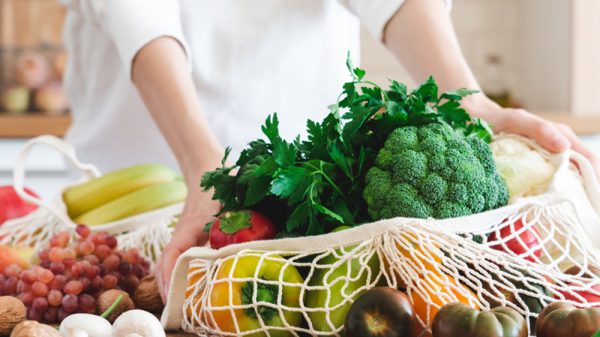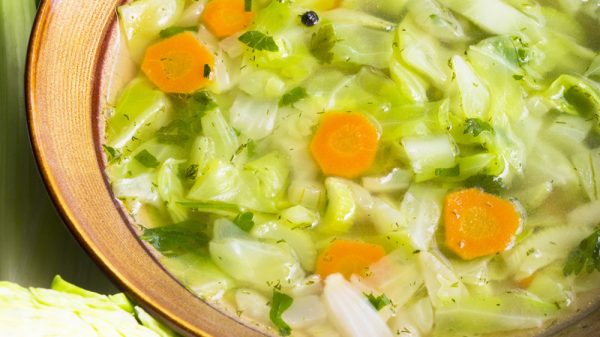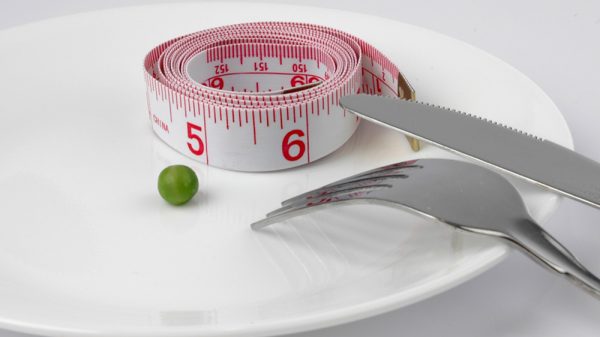You may have heard that healthy high protein meals are important to incorporate into your diet on a daily basis. But what exactly is protein? Protein is a macronutrient that the human body requires for nearly all biological processes. The digestive system breaks down protein into individual particles called amino acids. These amino acids are the raw materials for biological processes including the synthesis of muscle tissue, hormones, and enzymes.
Read on to find out about healthy high protein meals and how to increase your dietary protein intake.
Types of Amino Acids in Protein
Before we dive into healthy high protein meals, let’s first discuss the amino acids that the body uses from protein.
In general, there are two main types of amino acids that the body uses from food: essential amino acids and nonessential amino acids. Although nonessential amino acids are found in foods, the body can also synthesize them internally. On the other hand, the body is unable to synthesize essential amino acids, making them nutritionally required.
The nine essential amino acids are leucine, isoleucine, valine, threonine, methionine, histidine, lysine, phenylalanine, and tryptophan. Getting optimal ratios of these essential amino acids on a daily basis supports overall health and well-being.
How can you ensure that you’re getting the essential amino acids that you need? All animal proteins offer optimal ratios of essential amino acids. Excellent sources of animal protein include fish, chicken, beef, cheese, milk, and eggs. Make sure to choose low-fat dairy and lean meat, to reduce your intake of saturated fat.
What about vegetable proteins? Unlike animal protein, no single source of vegetable protein offers optimal ratios of essential amino acids. As a result, it’s important to combine vegetable proteins throughout the day to meet the body’s essential amino acid requirements. Whole grains, nuts, seeds, beans, and soy products are good plant-based protein sources.
Supplementation is also a helpful method for ensuring that the body gets the essential amino acids it needs, without the hassle of planning protein sources.
How Does the Body Use Essential Amino Acids?
The body uses essential amino acids in numerous biological processes. For example, essential amino acids are the raw materials used to build muscle fibers. Without enough essential amino acids, the body is unable to repair and rebuild muscle tissue. Getting optimal ratios of essential amino acids helps you maintain strength and agility throughout your lifetime.
Moreover, essential amino acids are used to build the components that help the metabolism, nervous system, and immune system function optimally. The body uses essential amino acids to build biological components like hormones, enzymes, neurotransmitters, and antibodies.
Healthy High Protein Meals
Are you looking for high protein recipes to incorporate into your weekly meal plans? Look no further. Here we provide a variety of healthy high protein meal options that fit every diet plan, from omnivorous to plant-based.
Quinoa Burrito Bowl
A quinoa burrito bowl is a protein-rich meal that also offers lots of fiber, vitamins, and minerals. So, how can you prepare a protein-packed burrito bowl? First, cook quinoa according to the directions. For extra flavor substitute vegetable broth for water when preparing the quinoa. Next, prepare your toppings. Choose low-fat ground meat to go with your burrito bowl. Ground turkey, ground chicken, and lean ground beef are great options. Cook the ground meat in a pan until thoroughly cooked. Season the meat with salt, pepper, chili powder, chipotle chili powder, cumin, paprika, salt, and pepper.
Next, prepare your beans and vegetables. Mix chopped bell peppers, onions, garlic, chopped kale, black beans, and corn in a pan. Season the vegetables with the same seasoning that you used for the meat.
Now, it’s time to prepare your burrito bowl. Layer quinoa with ground meat and vegetable mixture. Top with a squeeze of lime, cilantro, salsa, low-fat cheese, and guacamole.
Stuffed Bell Peppers with Couscous
Stuffed bell peppers are an easy and versatile dish that you can enjoy for lunch or dinner. First, prepare the stuffing using a mixture of high-protein ingredients, vegetables, and whole grains. For example, choose ground turkey, chickpeas, diced onions, chopped spinach, tomatoes, and couscous. Saute the turkey in a pan until thoroughly cooked. Season the turkey with sage, thyme, garlic powder, salt, and pepper. Next, add your chopped vegetables.
In a separate pan, prepare whole-grain couscous for the filling. Mix the couscous together with the ground meat, cooked vegetables, and cooked couscous. Season to taste and add to peppers. Top with low-fat shredded cheese and bake until the peppers are softened.
Baked Salmon with Bulgur
This Mediterranean-inspired dish offers lots of protein, healthy carbs, vitamins, and minerals. Baked salmon is an excellent high-protein dish because it is packed with optimal ratios of essential amino acids as well as healthy omega-3 fatty acids. Plus, salmon is simple to prepare. Place salmon fillets on a sheet pan, and season with salt, pepper, garlic powder, red pepper flakes, and lemon juice. Bake the salmon until cooked through.
Asparagus pairs well with salmon. Saute asparagus in a pan with a drizzle of olive oil, salt, and pepper. Serve the salmon and asparagus with a side of bulgur.
Oatmeal
Oatmeal may seem like a boring breakfast dish. However, there are ways to dress up oatmeal so that it is tasty and packed with even more protein, fiber, vitamins, and minerals.
First, cook whole oats on the stovetop or in the microwave as directed. Then, add in ground flaxseeds, ground Chia seeds, peanut butter, sliced bananas, blueberries, and a drizzle of honey.
Scrambled Eggs with Whole-Grain Toast
Eggs with toast is a simple, tasty, nutritious meal that offers tons of protein and fiber. First, whisk two egg whites and one egg yolk in a bowl. It’s helpful to use this ratio of egg whites to egg yolk, to avoid eating too much saturated fat. Add a splash of skim milk and season with a bit of salt and pepper. Pour the eggs into a heated pan and scramble until cooked through.
Prepare a slice of whole-grain toast with mashed avocado, low-fat feta cheese, and a squeeze of lemon juice. Top of the toast with the scrambled eggs, and enjoy.
As alternatives, you can also prepare eggs in the form of an omelet or frittata, with vegetables, ground meat, and low-fat cheese.
Salad with Grilled Chicken
Are you looking for light dinner ideas? Salad is a light dinner and provides an easy way to pack tons of veggies into one bowl. First, chop up your greens and veggies. Great examples of vegetables include spinach, kale, broccoli, arugula, bell peppers, tomatoes, cucumbers, artichokes, Brussels sprouts, and red onions. Top your salad with edamame, crushed walnuts, low-fat mozzarella cheese, and slices of grilled chicken. Choose chicken breast over chicken thighs, to reduce your intake of saturated fat.
Are you looking for high protein vegetarian meals? Simply leave out the chicken breast and substitute tofu or tempeh. Toss the veggies and protein with balsamic vinegar, olive oil, salt, and pepper.
Protein Pancakes
Try making a high-protein version of this classic breakfast food. Prepare protein pancakes using mashed bananas, almond flour, whole wheat flour, protein powder, eggs, and a bit of honey. Cook the protein pancakes on the griddle and top with mixed berries, crushed walnuts, the drizzle of maple sera up try making a high-protein version of this classic breakfast food. Prepare protein pancakes using mashed bananas, almond flour, whole wheat flour, protein powder, eggs, and a bit of honey. Cook the protein pancakes on a griddle and top with mixed berries, crushed walnuts, the drizzle of maple syrup.
Pasta with Meat Sauce and Veggies
Prepare pasta of your choice, such as penne pasta or spaghetti. Choose pasta that is made with lentils, chickpeas, or whole-grain flour, to ensure that you are getting as much protein and fiber as possible.
Prepare meat sauce by cooking lean ground beef with your favorite marinara sauce. As an alternative, you can also prepare meatballs instead of meat sauce. Add extra seasonings if needed, such as dried basil, garlic powder, and a bit of salt.
To incorporate more vegetables into the dish, add carrots, tomato, zucchini, and cauliflower to a blender and pulse until shredded. Pour the vegetable mixture into the sauce and lightly simmer. This is a great method for hiding lots and vegetables in your sauce. Toss the pasta and sauce together and top with a sprinkle of parmesan cheese.
Are you looking for a low-carb, low-calorie pasta alternative? Try swapping out pasta for zucchini noodles or spaghetti squash.
Greek Yogurt Parfait
Greek yogurt parfait is an easy and quick breakfast idea but also offers lots of high-quality protein. First, spoon a serving of nonfat Greek yogurt into a bowl. Layer with sliced bananas, mixed berries, crushed almonds, and crushed walnuts. For a little bit of extra sweetness, add a drizzle of honey or maple syrup.
Fajitas
Fajitas are a perfect weeknight meal that the whole family can enjoy. First, prepare the fillings. Lean ground beef, ground turkey, or crumbled tofu are great protein options to incorporate into your fajitas. Season the protein of your choice with chili powder, cumin, garlic powder, paprika, salt, and pepper.
Next, saute the medley of vegetables in a pan. Onions, broccoli, cauliflower, zucchini, mushrooms, and bell peppers are great options.
For the rest of the fajita ingredients, use whole-grain tortillas, shredded lettuce, black beans, corn, salsa, guacamole, cilantro, and lime wedges.
Tofu Stir-Fry
Tofu stir-fry is a healthy meal that can be enjoyed for lunch or dinner. Combine tofu slices, carrots, onions, peppers, broccoli, cauliflower, and any other vegetables of your choice in a pan. Saute with a drizzle of sesame oil and season with sweet chili sauce and peanut butter. Served over brown rice, if desired, and sprinkle with peanuts or extra crunch.
Bean Burger with Sweet Potato Fries
It’s possible to make healthy versions of your favorite comfort foods. Try making a bean burger using black beans, brown rice, chopped kale, shredded carrots, and egg. Blend the mixture and season with salt, pepper, and garlic powder. Use the bean mixture to form burgers and bake until cooked through.
For the sweet potato fries, cut sweet potatoes into wedges. Coat the wedges in olive oil and season with paprika, garlic powder, salt, and pepper. Place on a baking sheet and cook until easily pierced with a fork and slightly crispy on the outside.
When the burgers and fries are done, assemble your burgers and whole-grain buns with lettuce, tomato, mustard, and ketchup.
Protein Shake
Protein shakes are excellent snacks and can also be used as a meal replacement when you’re strapped for time. Just make sure that when you are using a protein shake as a meal replacement, the shake offers a sufficient amount of calories.
To prepare a nutritious, high-calorie protein shake, blend frozen bananas, blueberries, ground flaxseeds, ground chia seeds, a handful of spinach, peanut butter, protein powder, and almond milk. Blend until smooth.
French Toast
This version of French toast is packed with protein and fiber. Prepare your “custard” by whisking two egg whites, one egg yolk, skim milk, cinnamon, and a pinch of salt in a bowl. Dip slices of whole-grain bread into the mixture and cook in a pan. Enjoy slices of French toast with raspberries, blueberries, crushed walnuts, and a drizzle of maple syrup.
Extra Tips for a Healthy Lifestyle and Diet
Here are a few extra tips that complement a healthy high protein diet.
1. Getting Regular Physical Activity
Exercise is a vital part of a healthy lifestyle. Both aerobic exercise and strength training support overall health and well-being. In particular, strength training complements a high protein diet. Engaging in strength training encourages muscle growth and repair. In order to get stronger as a result of strength training, the body requires optimal ratios of essential amino acids from protein.
2. Eat Primarily Whole Foods
Whole foods are in their original form and are unprocessed or only minimally processed. Whole foods include fruits, vegetables, whole grains, nuts, seeds, beans, low-fat dairy, fish, and lean meats. Consuming primarily whole foods increases your intake of vitamins, minerals, and fiber while helping you avoid unhealthy additives.
3. Steering Clear of Junk Foods
To support overall health and well-being, limit your consumption of junk foods. Processed foods are filled with unhealthy ingredients like saturated fat, trans fat, refined grains, added sugar, and preservatives that negatively impact metabolic and cardiovascular health. Avoid foods like soda, candy, ice cream, pastries, chips, crackers, and frozen meals.
4. Eating the Right Number of Calories
It’s crucial to avoid both overeating and undereating. Overeating may sabotage weight loss goals, while undereating leads to muscle loss and malnourishment. Eating the right number of calories for your height, age, and activity levels supports your health.
5. Talk to Your Doctor and Registered Dietitian
It’s always a good idea to talk to your doctor and a registered dietitian to ensure that your diet aligns with any health conditions and specific needs.
Healthy High Protein Meals: Conclusion
Protein is a vital nutrient that supports biological functioning, from muscle development to immune system health. Getting plenty of protein that offers optimal ratios of essential amino acids is crucial for your health and well-being. Protein pancakes, salad with grilled chicken, and baked salmon are examples of healthy high protein meals to incorporate into your routine
























